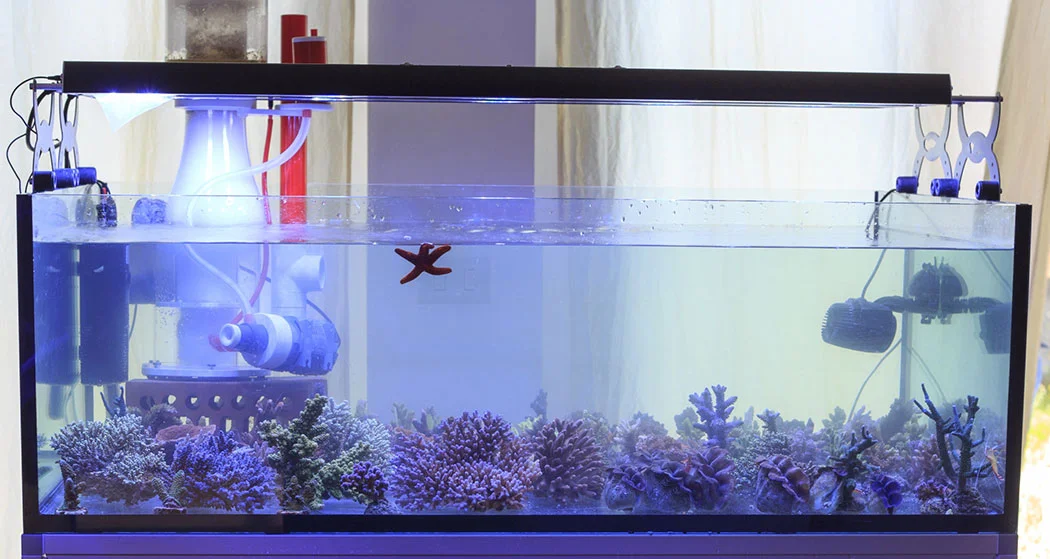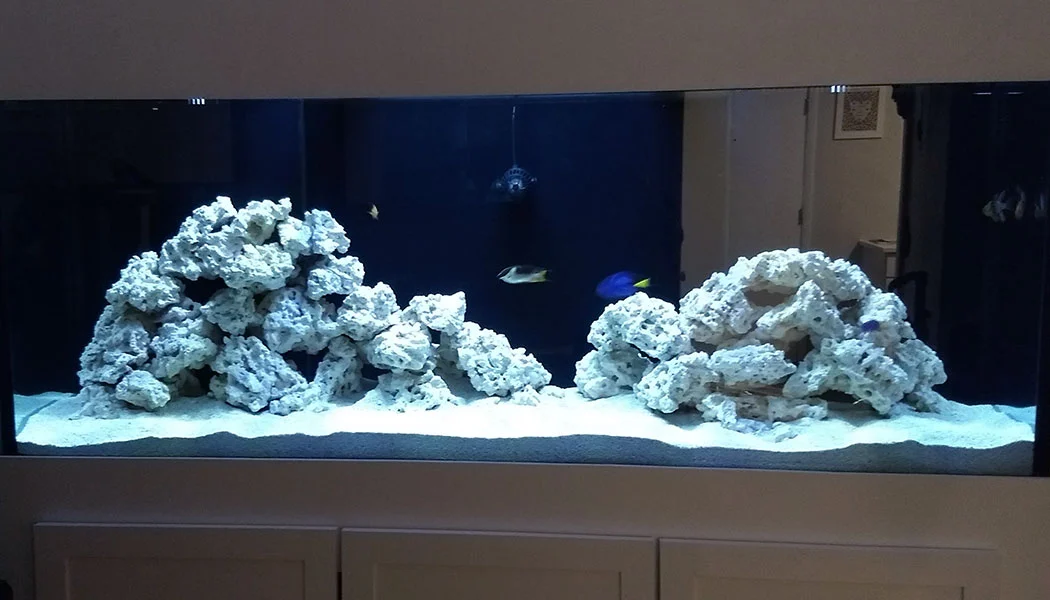Setting up a saltwater aquarium can seem complex. Without the right filtration and beneficial bacteria. Harmful toxins like ammonia and nitrites can build up, harming your fish and corals. Not to mention algae outbreaks.
I remember when I set up my first saltwater tank, I had a lot of questions on how to filter a saltwater aquarium. I knew it was important but I didn’t know anything.
In this guide, I will recommend some filtration methods and recommend the best ones. There’s something about having live rock, a protein skimmer, and a sump that leads to success.
With these recommendations, you can build a strong saltwater aquarium filtration system.
Table of Contents
Key Takeaways
- Proper filtration is essential to maintain water quality in a saltwater aquarium.
- Considering the size of your aquarium when choosing your filtration system.
- Biological, chemical, and mechanical filtration are all necessary components for a balanced aquarium.
The Importance of Filtration in a Saltwater Aquarium

Filtration in your saltwater aquarium is crucial for maintaining a healthy environment.
In saltwater tanks, waste quick breakds down into harmful compounds. These compounds like ammonia and nitrites, are toxic to aquatic creatures. These compounds are usually from fish waste, uneaten food, and decaying matter.
Without proper filtration, these toxins accumulate. Leading to poor water quality and unhealthy conditions for your marine inhabitants.
A well-filtered aquarium ensures:
- Reduced ammonia and nitrites.
- Balanced pH and salinity levels.
- Prevention of algae overgrowth.
- A thriving ecosystem for both fish and corals.
Types of Aquarium Filtration
A combination of mechanical, biological, and chemical filtration is your way to success. Each type of filtration uniquely removes waste, toxins, and debris from the water.
Below is a breakdown of the three best saltwater aquarium filtrations.
Types of Mechanical Filtration
Mechanical filtration is the first line of defense in keeping the water free of debris. The best filters are filter socks and a protein skimmer. There are other options that will work as well. Like canister filters and sponge filters.
A protein skimmer is going to be your best option for mechnaical filtration.
They work by removing larger particles before they break down into harmful chemicals. Such as uneaten food, fish waste, and floating algae. This type of filtration requires regular cleaning or replacement.
Mechanical filtration is most effective for:
- Preventing visible debris from clouding the water.
- Improving water circulation.
- Reducing the load on biological and chemical filters.
Popular mechanical filtration options include:
| Filter Type | Description |
|---|---|
| Protein Skimmers | Essential for saltwater tanks, skimmers remove organic waste before it breaks down. They help reduce organic compounds that contribute to ammonia, nitrite, and nitrate levels. |
| Filter Socks | Fine mesh or fabric socks that catch large debris in sump systems. These need regular washing or replacement to prevent clogging. |
| Sponge Filters | Simple, inexpensive filters that trap debris while offering some biological filtration. Great for smaller tanks. |
| Canister Filters | External filters that provide powerful mechanical and biological filtration for larger tanks. Requires regular cleaning. |
| Filter Pads | Installed in power filters or sumps, these pads catch debris from water flow and are easy to replace. |
Types of Biological Filtration
Biological filtration is crucial for breaking down toxic compounds. They help remove the same toxis like ammonia and nitrites.
This process is with beneficial bacteria that colonize on surfaces. Usually live rock and sand or a dedicated filter media. This bacteria converts harmful ammonia into nitrites, and then into nitrates. Which is less harmful and can be diluted through water changes.
Key biological filtration methods:
| Filter Method | Function |
|---|---|
| Live Rock | Provides a natural surface for beneficial bacteria growth. |
| Live Sand | Crushed coral is a popular choice for this. As it is a good platform for beneficial bacteria. Which will aid in biological filtration and promote a stable nitrogen cycle. |
| Bio-balls | Bio-balls Durable plastic spheres with large surface areas for bacteria. |
| Ceramic Media | Porous material that maximizes the surface area for bacteria. |
Types of Chemical Filtration
Chemical filtration removes dissolved toxins, organic compounds, and pollutants. These are usually too small for mechanical or biological filtration to handle.
It is particularly effective in removing substances like heavy metals, phosphates, and odors.
Chemical filtration options:
| Filter Type | Description |
|---|---|
| Activated Carbon | Absorbs impurities and helps clear discoloration or odors. |
| Phosphate Removers | Targets phosphates to prevent algae growth. |
| Resin Filters | Specialized media that remove heavy metals and toxins. |
Choosing the Right Saltwater Aquarium Filtration

The type of filtration should reflect these three factors for your tank.
- Aquarium size: Larger tanks require a more robust filtration system. Sump filters or large protein skimmers, to handle the increased waste load.
- Stocking levels: The number of fish and corals in your tank influences your filtration. Heavily stocked tanks will require a mix of filtration types to keep water clear.
- Budget and maintenance: Filtration systems range in price and complexity. Live rock and sand offer a low-maintenance natural filtration. While sump filters and protein skimmers require an initial investment. And chemical filtration requires more frequent maintenance and replacement.
Filtration Recommendations
Below are three I would recommend all tanks have: Live Rock & Sand, Sump, and a Protein Skimmer.
Live Rock & Sand
Live rock and live sand are the best natural biological filters. Having these ensures you always have beneficial bacteria to break down ammonia and nitrites. Having more rock and sand gives your bacteria plenty of areas to grow. Promoting a stable nitrogen cycle essential for water quality.
- Live Rock: Provides a large surface area for bacteria. This helps mimic the natural environment of marine fish and corals.
- Live Sand: Also supports bacteria growth. And also aids in maintaining stable pH levels while contributing to biological filtration.
Benefits:
- Natural filtration method.
- It helps maintain pH balance.
- Supports biodiversity in the tank.
This method is a low-maintenance option. It provides the most natural ecosystem for tanks with a low number of fish.
The amount of live rock and sand depends on the size of your tank. The rule of thumb is a one pound per gallon but this is always up for debate.
I think it’s a good starting point. For instance, if you have a 50-gallon tank, you should add 50 pounds of live rock.
Some retailers have useful calculators for live rock and sand. This will help you determine how much you need for your saltwater aquarium filter setup.
Sump Filters
Sump filters are external compartments that sit below the main aquarium. They house various filtration media, including mechanical, biological, and chemical filters.
Water flows from the display tank into the sump. Then passes through different filtration stages before being pumped back into the aquarium.
Sumps offer flexibility and allow for customized filtration setups. You can add protein skimmers, heaters, and reactors inside the sump. Keeping the main display tank equipment free and more visually appealing. They are ideal for larger tanks because you can have multiple filtration types.
Advantages:
- Customizable filtration options.
- Provides more water volume for better stability.
- Keeps the display tank free of equipment.
Sump filters require additional setup and plumbing. Making them more expensive and complex to maintain than other filtration methods.
Protein Skimmers
Protein skimmers are essential for removing organic waste in a saltwater tank. Skimmers work by creating bubbles that attract dissolved organic compounds. This creates a foam that rises to the surface and is collected in a waste cup.
Protein skimmers can help heavily stocked systems, where organic waste can accumulate quickly. They also help improve water clarity and oxygenation.
Key Features:
- Removes organic waste before it breaks down.
- Enhances oxygen exchange.
- Reduces nitrate buildup.
While they are highly effective. Skimmers can be costly and require regular cleaning to maintain efficiency. Their ability to remove waste early in the nitrogen cycle makes them an invaluable tool.
When shopping for protein skimmers, look at the reviews. Some of these can be quiet noisy with suction and vibrations.
Installing Your Filtration System

When you are setting up your saltwater aquarium, plan each component. Live rock and sand, the sump, and protein skimmers each have unique steps. Their installation must be done properly to ensure an efficient system.
Installing Live Rock
- Placement: Arrange live rock in areas of good water flow. Always keep a few inches of space between the glass. This will help with maintenance and prevent dead flow areas. This promotes oxygenation and ensures waste doesn’t settle in hard-to-reach areas.
- Stability: Ensure that the rocks are stable and secure. Prevent any movement that could cause harm to tank inhabitants or damage the tank itself.
- Surface Area: Maximize surface area by creating an open rockscape. This allows bacteria to thrive and ensures water can flow through the structure.
- Check for Proper Water Flow: After setting up the filter, observe the water flow. Ensure that water is circulating evenly throughout the tank. Watch for low-flow areas and adjust the position if necessary. Uneven water flow can cause waste accumulation in stagnant areas.
Installing Live Sand
- Layering: Add a 1-2 inch layer of live sand evenly across the tank bottom. For deeper sand beds, 3-4 inches can support additional filtration.
- Rinse First: Lightly rinse the sand before adding it to the tank to remove excess dust and debris.
- Avoid Compaction: Ensure the sand remains loosely packed. This will maximize water flow and bacterial activity.
Installing a Sump
- Plumbing Setup: Ensure proper plumbing is in place and secured. Check if water is flowing from the main tank to the sump and back via an overflow system.
- Water Level: Maintain consistent water levels in both the sump and display tank. Your overflow drain should be at the same rate as your return pump. If not, you can install a gate valve on your return pump to limit the flow and help balance.
- Media Organization: Arrange mechanical, biological, and chemical filtration media in separate compartments. This is the best for optimal performance.
Installing a Protein Skimmer
- Placement: Install the skimmer in the sump or as a hang-on-back unit. Ensuring it is positioned where the water flow is steady. Read your owner’s manual to see what water level it performs the best at.
- Bubble Adjustment: Adjust the skimmer to create fine bubbles. This will attract the most waste particles, collecting them in the skimmer cup. Usually, you want the bubbles about an inch or two above the cone shape.
Maintaining Your Filtration System

Regular aquarium maintenance is necessary to keep your filtration system working efficiently.
- Replace Filter Media: Chemical media like carbon or GFO needs to be replaced every 4 weeks. Overused carbon and GFO can lose their ability to absorb toxins. Always monitor the condition of the media and replace it as needed.
- Clean Protein Skimmers: Protein skimmers require regular attention to maintain their effectiveness. Empty the collection cup weekly. Clean the entire skimmer at least once a month to prevent clogs and buildup.
- Live Rock and Sand: Your live rock and sand is low maintenance. The only thing I would recommend is using a turkey baster on the rocks during water changes. Pushing water into the small sections of the rock will dislodge any build-up. The sand you can stir every so often to clean up and detritus that has built up over time.
Frequently Asked Questions
What is the best way to filter a saltwater aquarium?
The best way to filter a saltwater aquarium is using a combination of mechanical, biological, and chemical filtration:
- Mechanical: Use protein skimmers, canister filters, or sponge filters to remove solid debris.
- Biological: Incorporate live rock and live sand to host beneficial bacteria.
- Chemical: Add activated carbon to remove toxins and dissolved organic compounds.
- Sumps: Utilize a sump system to house additional filtration.
Do saltwater aquariums need a filter?
Yes, saltwater aquariums need a filter to maintain water quality and ensure the health of marine life.
Proper filtration:
- Removes waste and debris (mechanical filtration).
- Promotes the nitrogen cycle through beneficial bacteria (biological filtration).
- Eliminates harmful chemicals and toxins (chemical filtration).
- Enhances water clarity and oxygen levels with protein skimmers.
Without filtration, harmful compounds like ammonia and nitrites would build up. Leading to poor water quality and unhealthy tank conditions
How to filter a saltwater aquarium?
To filter salt water in a fish tank:
- Install a Sump, Canister Filter, or Hang-on-Back Filter for mechanical filtration.
- Add Live Rock and Live Sand for biological filtration.
- Include a Protein Skimmer to remove organic waste before it breaks down.
- Use Activated Carbon to eliminate toxins and odors.
- Perform Regular Water Changes to help maintain water quality.
How often should I clean my saltwater aquarium filter?
You should clean mechanical and replace chemical filter media every 4 weeks. Avoid disturbing biological filtration too much, as it houses beneficial bacteria.
Can I use freshwater filters in my saltwater tank?
No, freshwater filters are not designed to handle the salt and waste produced in a saltwater environment.
 Mixed Reef Tank
Mixed Reef Tank
